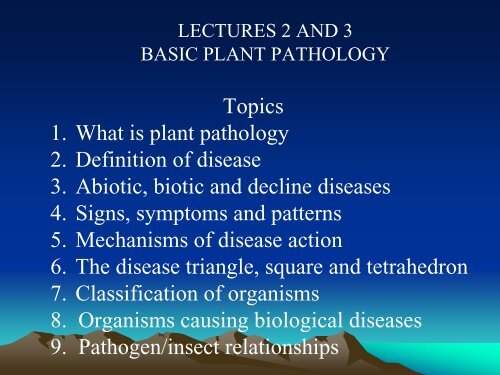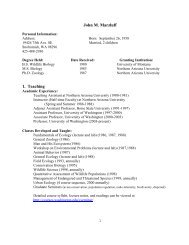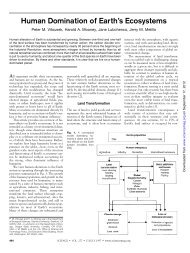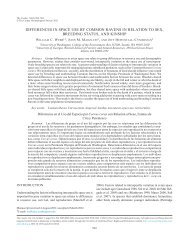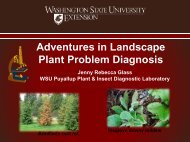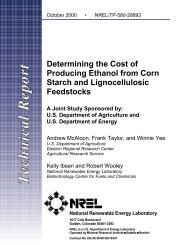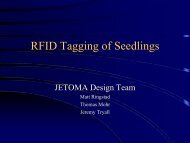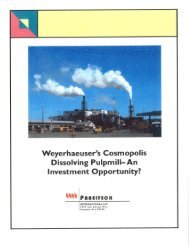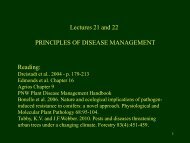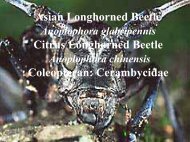Lectures 2 and 3 - Introduction to Plant Pathology
Lectures 2 and 3 - Introduction to Plant Pathology
Lectures 2 and 3 - Introduction to Plant Pathology
Create successful ePaper yourself
Turn your PDF publications into a flip-book with our unique Google optimized e-Paper software.
LECTURES 2 AND 3<br />
BASIC PLANT PATHOLOGY<br />
Topics<br />
1. What is plant pathology<br />
2. Definition of disease<br />
3. Abiotic, biotic <strong>and</strong> decline diseases<br />
4. Signs, symp<strong>to</strong>ms <strong>and</strong> patterns<br />
5. Mechanisms of disease action<br />
6. The disease triangle, square <strong>and</strong> tetrahedron<br />
7. Classification of organisms<br />
8. Organisms causing biological diseases<br />
9. Pathogen/insect relationships
Reading<br />
Basic plant pathology<br />
• Chapter 8 <strong>and</strong> Chapter 10 Edmonds, Gara <strong>and</strong><br />
Agee<br />
• Reserve reading:<br />
Agrios (2005): Chapters 1-3, Chapter 10 (Abiotic<br />
diseases), Fungi (Chapter 11),<br />
Bacteria <strong>and</strong> Phy<strong>to</strong>plasmas (Chapter 12),<br />
Parasitic higher plants (Chapter 13),<br />
Viruses (Chapter 14), Nema<strong>to</strong>des, (Chapter 15).
1. What is plant pathology – the study of<br />
the organisms <strong>and</strong> environmental<br />
fac<strong>to</strong>rs that cause diseases in plants,<br />
mechanisms by which they cause<br />
disease, <strong>and</strong> methods of managing<br />
diseases <strong>and</strong> reducing damage.<br />
2. Definition of disease - sustained<br />
physiological <strong>and</strong> structural damage <strong>to</strong><br />
plant tissues caused by biological <strong>and</strong><br />
non-biological agents ending sometimes<br />
in plant death.
YOU<br />
TREE<br />
Skin diseases<br />
Foliage diseases<br />
Cankers<br />
Ozone<br />
Heart rot<br />
Athlete’s foot<br />
fungus<br />
Vascular system<br />
diseases – Dutch<br />
Elm disease<br />
Root diseases
3. Biotic, abiotic <strong>and</strong> decline<br />
diseases<br />
Biological – fungi, bacteria, etc.<br />
non-biological (abiotic)<br />
decline (combination – distinct<br />
causes may be unknown).
Non-biological agents - excesses of<br />
temperature <strong>and</strong> moisture, nutrient deficiencies<br />
or excesses, air pollution, etc.
4. Signs, Symp<strong>to</strong>ms <strong>and</strong> Patterns<br />
a. Signs - indications of presence of<br />
disease causing organism – e.g., fruiting<br />
body or mycelium of fungi<br />
b. Symp<strong>to</strong>ms - change in host -<br />
exudations, resinosis, necrosis (death of<br />
tissue or tree), hypotrophy (dwarfing),<br />
hypertrophy (overgrowths - galls, witches<br />
brooms).<br />
c. Patterns – r<strong>and</strong>om – biotic agents<br />
- systematic - abiotic
Tar spot on maple leaf caused by a<br />
fungus- R<strong>and</strong>om pattern
Iron deficiency – abiotic – systematic pattern
How do we establish that fungi caused<br />
the observed disease<br />
Rules of proof “Koch's postulates”<br />
i. Establish constant association of organism<br />
<strong>and</strong> disease symp<strong>to</strong>ms.<br />
ii. Isolate organism <strong>and</strong> grow in pure culture.<br />
iii. Inoculate healthy plant <strong>and</strong> produce<br />
disease symp<strong>to</strong>ms<br />
iv. Re-isolate organism.
5. Mechanisms of disease action<br />
Production of enzymes (pectinase,<br />
cellulase)<br />
Toxins<br />
Hormones (giberellin)<br />
Physically plugging conducting tissues<br />
Nutrient competition
6. The disease triangle - plant, pathogen, <strong>and</strong> environment
7. Classification of organisms
DOMAINS AND KINGDOMS
Tree of Life
Classification of fungi<br />
(Fusarium<br />
solani – important plant pathogen)<br />
Domain- Eukarya Eurarya<br />
Kingdom- Fungi Fungi<br />
Phylum- ----mycota Ascomycota<br />
Class- ----mycetes Euascomycetes<br />
Subclass- ----tidae<br />
Pyrenomycitdae<br />
Order- ----ales Hypocreales<br />
Family- ----aceae Hypocreaceae<br />
Genus<br />
Fusarium<br />
Species<br />
solani<br />
Forma specialis<br />
f. sp. gladioli<br />
Race 1
Classification of insects<br />
(Asian long-horned beetle)<br />
Domain-<br />
Kingdom-<br />
Phylum-<br />
Class-<br />
Subclass<br />
Division<br />
Order-<br />
Suborder<br />
Superfamily<br />
Family<br />
Subfamily<br />
Tribe<br />
Genus<br />
Species<br />
1<br />
Eurarya<br />
Animalia<br />
Arthropoda<br />
Insecta<br />
Pterygota<br />
Endopterygota<br />
Coleoptera<br />
Polyphaga<br />
Chrysomeloidea<br />
Cerambycidae<br />
Lamiinae<br />
Monochamini<br />
Anaplophora<br />
glabripennis
8. Organisms causing biological<br />
disease<br />
• Fungi <strong>and</strong> fungus-like organisms<br />
• Viruses, viroids, <strong>and</strong> prions<br />
• Bacteria<br />
• Phy<strong>to</strong>plasmas<br />
• Nema<strong>to</strong>des<br />
• Parasitic plants<br />
• Pro<strong>to</strong>zoans
<strong>and</strong> fungus-like organisms
Fungi cause the greatest problems on woody plants<br />
because they have enzymes <strong>to</strong> break down cellulose<br />
<strong>and</strong> lignin. Bacteria <strong>and</strong> viruses more of a problem<br />
on soft tissued plants.
Perhaps a million species of fungi, but only 100,00 are<br />
known. 10,000 are plant pathogens
Phylum<br />
Role<br />
Fungus-like organism<br />
Oomycota Damping off, feeder (fine) root diseases<br />
True fungi<br />
Zygomycota<br />
Saprophyte, endomycorrhizal fungi, few<br />
pathogens (s<strong>to</strong>rage molds)<br />
Ascomycota Saprophyte, ec<strong>to</strong>mycorrhizal fungi,<br />
(Deuteromycota) foliage diseases, cankers, vascular wilts,<br />
fine root diseases, powdery mildews, stain fungi<br />
Basidiomycota<br />
Saprophytes, ec<strong>to</strong>mycorrhizal fungi,<br />
stem <strong>and</strong> branch decays, structural root diseases,<br />
rusts
FEATURES OF FUNGI AND FUNGAL-LIKE ORGANISMS<br />
Phylum<br />
Features<br />
Hyphae<br />
Cell walls Spores<br />
Sexual<br />
Asexual<br />
Oomycota<br />
(fungal-like)<br />
Zygomycota<br />
no septa glucans/cellulose Oospores zoospores<br />
TRUE FUNGI<br />
no septa glucans/chitin Zygospores sporangiospores<br />
Ascomycota septa glucans/mannans Ascospores conidia<br />
Deuteromycota septa glucans/mannans<br />
None conidia<br />
Basidiomycota septa glucans/mannans Basidiospores conidia,<br />
(with<br />
(rarely)<br />
clamps)
Features of fungi<br />
The vegetative body of fungi is the mycelium (made up of thread-like<br />
hyphae – with <strong>and</strong> without septa) which grow through or on substrates.<br />
Fungi disperse widely by spores which can be either asexual or sexual.<br />
The most commonly produced spores are asexual conidia or<br />
conidiopsores. Other asexual spores are sporangiospores. Sexual spores<br />
include zygospores, ascospores <strong>and</strong> basidiospores; they are produced in<br />
fruiting bodies. Spores can be airborne, spread by rain splash or water or<br />
by insects, other animals <strong>and</strong> humans.<br />
Oomycota were once included in the Fungi but are now considered<br />
<strong>to</strong> be fungal-like organisms. Oomycota have asexual spores (zoospores)<br />
<strong>and</strong> sexual spores (Oospores).<br />
Many fungi have resting stages - chlamydospores or sclerotia
Nectria perithecia<br />
Peziza apothecia<br />
Ascomycota
Nectria<br />
Canker –<br />
Ascomycota
Ascomycete Fungus- Tar spot on maple leaf
Deuteromycete fungus – Penicillium conidia
Basidiomycete hyphae<br />
showing clamp connections. Also<br />
associated yeast cells <strong>and</strong> bacteria<br />
Basidiomycete hyphae decaying<br />
wood cells – clamp connections <strong>and</strong> Ca<br />
oxalate crystals
Basidiomycete fungus – Armillaria mushroom
Basidiomycete fungus – conk or fruiting body
Obliga<strong>to</strong>ry pho<strong>to</strong> of famous old guy<br />
Robert HARTIG (1839 - 1901)<br />
Father of Forest <strong>Pathology</strong>
White Pine Blister Rust –<br />
Basidiomycota
OOMYCOTA LIFE CYCLE
Other Pathogens<br />
• Viruses, viroids, <strong>and</strong> prions<br />
• Bacteria<br />
• Phy<strong>to</strong>plasmas<br />
• Nema<strong>to</strong>des<br />
• Parasitic plants<br />
• Pro<strong>to</strong>zoans
Viruses, viroids,<br />
<strong>and</strong> prions<br />
• Viruses – protein<br />
coat <strong>and</strong> nucleic<br />
acid<br />
• Viroid – low MW<br />
RNA<br />
• Prion –<br />
infectious protein<br />
molecule
Viruses <strong>and</strong> viroids<br />
• Needs a vec<strong>to</strong>r<br />
–Insects<br />
– Nema<strong>to</strong>des<br />
– Grafting or vegetative propagation<br />
• Can move through plant in phloem or<br />
xylem, or stay localized in foliage<br />
• Can become part of plant genome
Symp<strong>to</strong>ms<br />
• Foliage streaking, spotting, mottling<br />
• Brooms or rosettes<br />
• Growth reduction<br />
• No symp<strong>to</strong>ms
Camelia mosaic virus
Bacteria<br />
• 1-celled prokaryotes with a cell wall<br />
• Rods (bacilli), spirals, or spherical<br />
(cocci)<br />
• Easily exchange genetic material on<br />
plasmids
Symp<strong>to</strong>ms<br />
• Bacteria cause disease by<br />
enzymes that digest cell<br />
walls, <strong>to</strong>xins, or tumors<br />
• Typical symp<strong>to</strong>ms are:<br />
– Water soaking<br />
– Wetwood<br />
– Shoot blight<br />
– Bleeding cankers<br />
–Galls
Bacterial Wetwood<br />
• Very common on elms<br />
<strong>and</strong> poplars<br />
• Caused by anaerobic<br />
bacteria in the xylem<br />
following wounding <strong>and</strong><br />
wound closure<br />
• May prevent decay<br />
fungi from colonizing
Crown Gall<br />
• Caused by Agrobacterium<br />
tumifaciens, a soil bacterium<br />
• Usually occurs at the soil<br />
line, but sometimes on<br />
aerial parts<br />
• Requires wounding for<br />
infection<br />
• Galls interfere with nutrient<br />
<strong>and</strong> water flow<br />
• Used in genetic engineering<br />
– can insert DNA in<strong>to</strong> plant<br />
genome
Elm bacterial gall
Important genera of bacteria<br />
Causing plant diseases<br />
Pseudomonas<br />
Xanthomonas<br />
Agrobacterium<br />
Bacillus<br />
Clostridium<br />
Strep<strong>to</strong>myces<br />
Bacterial leaf spot
Phy<strong>to</strong>plasmas<br />
• Also called MLO’s, or<br />
Mycoplasm-like<br />
organisms<br />
• Like bacteria without cell<br />
walls<br />
• Cannot be cultured apart<br />
from the host
Symp<strong>to</strong>ms<br />
• Infect phloem <strong>and</strong> cause a<br />
systemic, lethal disease<br />
• Causes elm yellows, X<br />
disease of cherry, coconut<br />
lethal yellowing, <strong>and</strong><br />
others<br />
• Symp<strong>to</strong>ms: yellowing,<br />
epinasty, witches brooms,<br />
defoliation
Elm Yellows – Phy<strong>to</strong>plasma disease
Nema<strong>to</strong>des<br />
• Worm-like animals in<br />
Phylum Nemahelminthes<br />
• Various parasitic habits<br />
• Usually in the soil or on<br />
roots, more of an issue in<br />
agriculture<br />
" If all the matter in the<br />
universe except the<br />
nema<strong>to</strong>des were swept<br />
away, our world would still<br />
be dimly recognizable..."<br />
-N.A. Cobb, 1914
Pine Wilt Nema<strong>to</strong>de<br />
• Bursaphelenchus<br />
xylophilus, vec<strong>to</strong>red<br />
by Monochamus sp.<br />
(Cerambycidae)<br />
• Introduced <strong>to</strong> Asia<br />
from North America
Pine wilt nema<strong>to</strong>de<br />
Pine wilt nema<strong>to</strong>de<br />
symp<strong>to</strong>ms<br />
Root nema<strong>to</strong>de
Mode of Action<br />
• <strong>Plant</strong> parasitic nema<strong>to</strong>des have a stylet <strong>to</strong><br />
pierce plant cell walls<br />
• Cause injury by feeding, <strong>to</strong>xins<br />
• Vec<strong>to</strong>rs of other diseases<br />
• Contributing fac<strong>to</strong>rs in declines<br />
• Indirect damage
Parasitic <strong>Plant</strong>s<br />
Evolution <strong>to</strong>wards parasitism has occurred<br />
at least 8 times in the flowering plants.<br />
Many are in the order Santalales:<br />
• Loranthaceae – leafy mistle<strong>to</strong>es<br />
• Santalaceae – root <strong>and</strong> stem<br />
hemiparasites<br />
• Viscaceae<br />
– Phoradendron – leafy mistle<strong>to</strong>es<br />
– Arceuthobium – dwarf mistle<strong>to</strong>es
True Mistle<strong>to</strong>es<br />
• Phoradendron sp. -<br />
– Common on oaks<br />
– South of 40-45 lat.<br />
– Cause water stress,<br />
usually not lethal<br />
– Spread by birds
True mistle<strong>to</strong>e on oak in California
• Arceuthobium spp.<br />
– Host-specific<br />
– Conifer hosts<br />
– Dioecious<br />
– Sticky seeds spread by<br />
birds or forcefully<br />
ejected from plant<br />
Dwarf<br />
Mistle<strong>to</strong>es
Dwarf mistle<strong>to</strong>e
Symp<strong>to</strong>ms<br />
• Parasitic plants are<br />
usually visible<br />
• Brooming<br />
• Galls<br />
• Reduced growth
Pro<strong>to</strong>zoans such as phy<strong>to</strong>flagellates<br />
can parasitize milkweed, <strong>to</strong>ma<strong>to</strong>,<br />
onion <strong>and</strong> chive plants.
9. Insect/Pathogen relationships<br />
a. Virus spread by plant hoppers, aphids<br />
b. Fungi spread by:<br />
bark beetles – Dutch elm disease fungus<br />
wood wasps (Sirex) – Hema<strong>to</strong>stereum<br />
c. Nema<strong>to</strong>des spread by bark beetles –<br />
Pine wilt disease<br />
d. Bark beetles <strong>and</strong> root diseases are<br />
closely associated


